- April 24, 2024
-
-
Loading

Loading

For those excited by growth in the heart of the city, 2015 seems to be another step in the right direction.
Work continues on many high-profile projects already under construction: Vue Sarasota Bay at U.S. 41 and Gulfstream Avenue, One Palm along Ringling Boulevard, and the Jewel in the 1900 block of Main Street.
In July, the city completed the State Street parking garage, which includes 395 parking spaces and more than 17,000 square feet of commercial space. Nearby, a project more than a decade in the works is moving forward.
The Kolter Group, the team behind Vue Sarasota Bay, purchased the rights to a development in the 1400 block of State Street in October. Formerly the second phase of Pineapple Square, the 11-story project would include 157 residential units and 50,000 square feet of commercial space.
Discussing the decision to move ahead with the development, Kolter Urban Project Manager David Arent spoke highly of the Sarasota market.
“Sarasota itself is what’s driving us to stay in the area,” Arent said.
Two other projects got a green light to proceed in October. DeMarcay on Palm, located at 33 S. Palm Ave., will be constructed on the site of the historic DeMarcay Hotel and Roth Cigar Factory buildings. The 18-story condo project, originally planned in 2006, will include 39 units. The city also issued a permit for an 18-story, 180-room Embassy Suites at 202 N. Tamiami Trail.
"Sarasota itself is what’s driving us to stay in the area." — David Arent
Even considering the high-profile projects approved this summer, city officials believe the downtown development environment suffered a blow in September. Despite overtures from the city, the County Commission unanimously voted to end the Downtown Community Redevelopment Area in 2016.
Established in 1986 to combat slum and blight, the CRA has used property tax revenue from within the downtown area to fund capital projects, such as improvements to Bayfront Park or the Whole Foods complex on First Street. Although the city still believed the CRA was a vital tool, the county thought it had served its purpose and that funds were often inappropriately spent.
County officials made it clear that they weren’t planning on ending their support for projects in downtown Sarasota. In September, the county restarted its Community Reinvestment Program, establishing a fund for grants or loans to municipalities for projects that “strengthen existing communities.”
City Commissioner Shelli Freeland Eddie has expressed her interest in continuing to work collaboratively with the county downtown. This month, she initiated a discussion among commissioners regarding future projects within the CRA boundaries.
"We have infrastructure needs that will not stop simply because the (CRA) funds are no longer there." — Norm Gollub
Those potential undertakings included the redevelopment of Main Plaza and Hollywood 20 within the 1900 block of Main Street, the possible relocation of the downtown SCAT transfer station on First Street and the redevelopment of the former Quay site on U.S. 41.
As the CRA winds to an end, the Downtown Improvement District is exploring the possibility of expanding its reach. Although DID officials contemplated assuming the boundaries of the old CRA, the self-taxing body of property owners is considering expanding to the Rosemary District as a first step.
Downtown Economic Development Coordinator Norm Gollub, a member of the city advisory committee studying the potential expansion, said he believes it’s vitally important to have a funding mechanism to support improvement projects throughout downtown.
“We have sidewalk needs, we have street improvement needs,” Gollub said. “We have infrastructure needs that will not stop simply because the (CRA) funds are no longer there.”